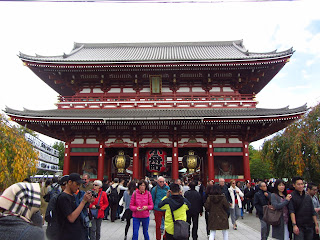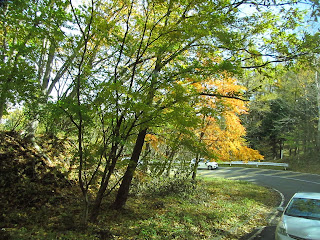 |
| Ueno Park - the Shinobazu Pond |
Ueno park itself is a spacious, yet bustling park. Likely because of its fame, as well as the numerous things to do within the park. The two museums we visited were at either end of the park, so I can say we walked through the entire length of the park, from the Shitamachi, past the old Kiyomizu Kannodo temple in the middle, to the Tokyo National Museum on the other end.
 |
| Our guide at the Shitamachi Museum |
We went next to the Tokyo National Museum. It’s totally unlike the Shitamachi, being a huge three-building complex around a central square. And of course, being a national museum, it has a far broader scope than just old Tokyo. The advice was if you have only a few hours, visit the Japanese gallery so that’s what we did. We didn't have a friendly Mr Fuji to show us around. But the exhibition guide is pretty good and the exhibits themselves clearly labelled.
The main exhibition in the Japanese Gallery presents the “Highlights of Japanese Art” and indeed it was a well curated journey through the history of Japanese art, across different items from the traditional pottery ware, paintings and wood block prints, to kimonos, samurai armour and even a fire-fighters’ jacket. There were also horse armour, and a room full of wonderful Japanese painted screens. It was a truly educational visit, probably my first extensive experience of this aspect of Japanese arts and culture (as opposed to appreciating cherry blossoms or autumn leaves). The only slight disappointment was that I was hoping very much to see some original woodblock prints of Mt Fuji, namely Hokusai’s famous “The Big Wave” taken from his “Thirty-six views of Mt Fuji” but apparently it’s not on display. I am however pleased to say that thanks to Youtube, it is possible to look at all thirty-six views online.
The main exhibition in the Japanese Gallery presents the “Highlights of Japanese Art” and indeed it was a well curated journey through the history of Japanese art, across different items from the traditional pottery ware, paintings and wood block prints, to kimonos, samurai armour and even a fire-fighters’ jacket. There were also horse armour, and a room full of wonderful Japanese painted screens. It was a truly educational visit, probably my first extensive experience of this aspect of Japanese arts and culture (as opposed to appreciating cherry blossoms or autumn leaves). The only slight disappointment was that I was hoping very much to see some original woodblock prints of Mt Fuji, namely Hokusai’s famous “The Big Wave” taken from his “Thirty-six views of Mt Fuji” but apparently it’s not on display. I am however pleased to say that thanks to Youtube, it is possible to look at all thirty-six views online.
 |
| Japanese painted screen |
In between the two museums, we went for lunch at the nearby Ameyoko Market, situated under the train tracks. We found this nice unagi (eel) restaurant, Unatoto, which sells nice little unagi based set lunches with a little bit of salad, pickles and soup on the side.
For dinner, we went to a supposedly healthy restaurant, Midori no Kitchen, in Ueno Station (the sort which prints the number of calories per meal) which was recommended by Tsunagu Japan. Not really "authentic" Japanese, but in a way it was nice to have a change! Thus ended our cultural day in Tokyo!
Food photos below, for more photos on Ueno and the two museums, check out my Flickr page here.








































